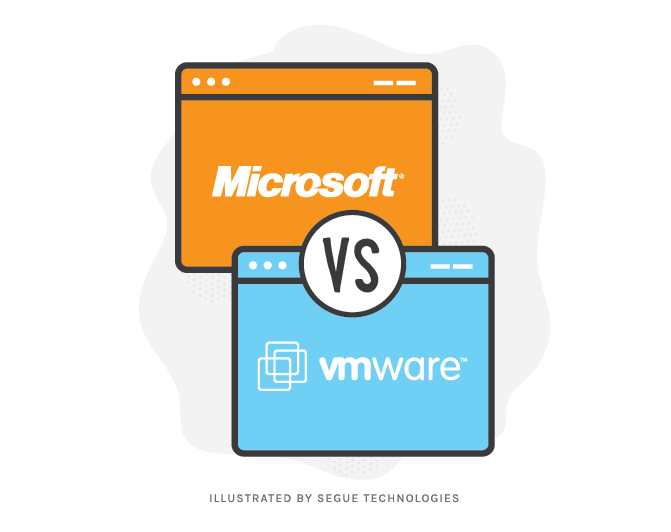VMware and Hyper-V are two competitive Hypervisors (software, firmware, or hardware that creates and runs Virtual Machines) that are available in the market today. While VMware needs vCenter to really make all its features usable, Hyper-V relies on the System Center suite of products to provide additional functionality. While there are pros and cons to both systems, if you are running mostly Microsoft products in your datacenter, it may make more sense to use Hyper-V.

Until recently, deciding between VMware and Hyper-V would have been a no-brainer. If you really wanted stability, performance and features, then VMware was the way to go. However with the release of Hyper-V 2012, things have changed. Hyper-V 2012 has all the stability and features you’d expect from an enterprise grade product and is a very powerful tool, especially if paired with System Center Virtual Machine Manager. To get a better look at these two hypervisor options, I’m providing a comparison in this blog.
Look at the Free Versions
The advantages of using Hyper-V over VMware multiply if you compare their free versions. This is because there are a few very interesting things that free Hyper-V 2012 can do which free VMware cannot, such as live migration of VMs with nothing shared in between two Hyper-V hosts, which systems administrators would immediately recognize as beneficial. Currently, if there is a need to migrate a VM from one host to another, your only option is to shut down the VM, copy the virtual hard disks files and configure a new VM on the new host using those files. This is usually a tedious process to say the least and the lengthy downtime involved can extend to hours or even days, depending upon the size of your VM. However, if you have free Hyper-V, you can migrate your VM live. The (free) Hyper-V manager tool lets you live migrate a VM between two hosts even if there is no shared storage between the hosts.
Components like Configuration Manager, Virtual Machine Manager, Data Protection Manager, Orchestrator, and App Controller, each provide powerful capabilities. They do add complexity if compared with VMware’s vCenter, but add a huge number of features and capabilities which are not there in VMware.
Price
Another big advantage of Hyper-V is price. For many government agencies and large businesses it may be free. If not free, it’s usually included with the Software Assurance agreement most government agencies already have in place with Microsoft. Furthermore, Virtual Machine Manager (VMM), the equivalent of VMware’s management tool like vCenter (which can be pretty expensive to purchase) is also free/included with Software Assurance. VMM essentially supercharges Hyper-V. Once you use VMM you just cannot go back to a standalone Hyper-V farm.
Another thing I would like to point out is that VMware charges a pretty premium price for High-Availability type features. In contrast, these features come included in the “purchase price” of Hyper-V. Hyper-V nodes can also be clustered. Even services can be clustered in a Hyper-V farm. Hyper-V also supports running VMs on servers running SMB 3.0. That means that now even the smallest IT shops can stand up a highly available cluster without buying a SAN. With small shops with limited IT personnel and know-how, this may be a deal maker. Not everyone wants the complexity and learning curve associated with an iSCSI or Fiber Channel SAN. SMB and Windows Server 2012 lets you use existing servers and disk arrays (read: cheap or free) for creating shared storage.
Advantages for Microsoft Shops – Product Integration
For a Microsoft shop, there are even more advantages of using Hyper-V 2012. Most big organizations have Software Assurance, and with that comes System Center. These two components of System Center that provide essential features to your Microsoft Hyper-V based server infrastructure:
1. Virtual Machine Manager (VMM) – used for managing Hyper-V hosts, clusters, and virtual machines
2. Operations Manager (which integrates with VMM to automate load balancing and provide health and performance monitoring),
Licensing Costs for Your VMs
Licensing costs for your VMs is also a very important consideration. For example, Windows Server 2012 Datacenter licenses include an unlimited number of VMs on a single machine. That one license will allow you to run tens of server VMs without any additional licensing fees. If you run with VMware you will have to pay for each and every Windows server, which you host on top of the VMware host. That means huge savings if you go with Hyper-V.
As you can see, Hyper-V 2012’s enterprise level stability, close integration with Microsoft products, price advantage and features give it a strong advantage over VMware in many cases.